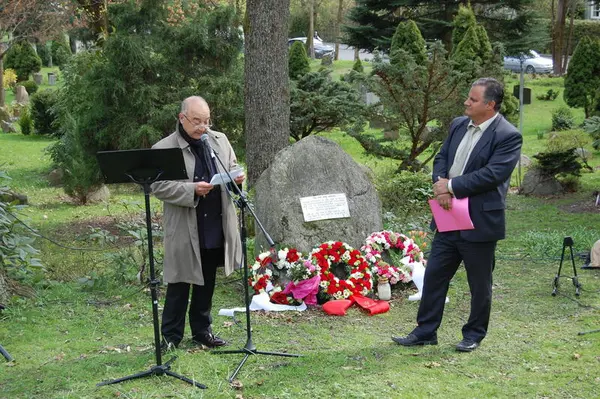The Stone of Shame
At Ris cemetery in Oslo you will find the “Stone of Shame”, a memorial to the grim part of the Travellers’ story. In 1965, a common grave intended for patients from Gaustad Hospital who were considered “entirely homeless and without ties” was established here. The grave was in use as late as 1987. It is assumed that several of the patients buried here were of Tater descent.
As part of the committee work in connection with Official Norwegian Report 2015:7, full access was given to patient records showing who was buried here. The investigation showed that 28 women and 27 men are buried in the common grave. These 55 people were all patients at Gaustad Hospital, but so far only one of the patients has been documented as being of Tater descent. The patient records show that more than 10 of the patients did not have a known birthplace, and some were without a permanent address. On this basis, the possibility that more of the people buried here were of Tater descent cannot be excluded.
The woman who has been identified as a Tater was removed from her parents and placed in one of the orphanages run by the Mission in 1926, at the age of 16. In 1927, at 17, she was committed to Gaustad Hospital, where she stayed until her death 43 years later. We do not know if she was sterilised or lobotomised, but her record shows that she was subjected to electroshock therapy and given antipsychotic medication (Haave 2015).
An annual ceremony, held by the National Tater Association every 7 May at the “Stone of Shame”, remains an important symbolic event and a reminder of the injustice the Tater people have suffered throughout history.
- 1/2
Ceremony at the stone of shame by the Ris church in 2012. Foto: Anno Glomdalsmuseet. - 2/2
Wreath laying ceremony at the stone of shame. Erwin Koht og Holger Gustavsen, 2012. Foto: Anno Glomdalsmuseet
Sørlandet orphanage and Svanviken
Two of the most important sites associated with the history of abuse are Sørlandet orphanage at Greipstad in Vest-Agder and Svanviken work camp at Nordmøre. There is a desire among the Tater organisations to preserve these places as evidence of the abuses.
- 1/1
Svanviken work camp. Foto: Privat / Anno Glomdalsmuseet
Construction of the Sørlandet orphanage was completed in 1927, and it was run by the Norwegian Mission for the Homeless until 1957. Svanviken was initially a work camp established in 1908, where the Tater people would learn to become residents. In the 1970s Svanviken became a family centre for disadvantaged Tater families. Svanviken closed in 1989. The ownership of Svanviken has become a matter of dispute since the Astrup family donated the property to the work among the homeless in 1900.
After the Norwegian Mission for the Homeless changed its name to the Church Social Services (now Crux), its mandate is no longer to work for the Tater people as a group. Many believe, therefore, that Svanviken should belong to the Tater people and not to a private organisation.
Memorial to "Stor-Johan" and Ulla
On 25 September 2022, a monument to the “Tater king” “Stor-Johan” and Lena Ulrikke (Ulla) was unveiled at Gjesåsen Church in the municipality of Åsnes in Solør, Innlandet county.
- 1/1
Memorial of Big-Johan and his wife Ulla at Gjesåsen church in Solør. Foto: Anno Glomdalsmuseet
“Stor-Johan”, or Karl Johan Algot Løvgren Fredriksen, was born in 1850 and died in 1946. His descendants consider him a great leader and a talented and honourable trader and craftsman. He and his wife, Lena Ulrikke Karlsdatter Stålberg, who was born in 1850 and died in 1912, raised 17 children.
It was Sara Wilhelmsen, her grandfather Karl and her father Frank (Wilhelmsen both) who were the driving force behind the raising of the monument, and the Anno Glomdal Museum has contributed to the project.
- 1/2
Sara, Frank and Karl Wilhelmsen at the unveiling of the memorial, with Kari Heggelund, mayor in Åsnes. Foto: Anno Glomdalsmuseet - 2/2
Sara, Frank and Karl by the memorial. Foto: Anno Glomdalsmuseet
Sara Wilhelmsen describes her great-great-grandfather as a representative and hero of the Tater culture:
"There aren’t that many historical monuments in tribute to Tater/Romani people, so raising this stone it’s about honouring him and Ulla as ancestors to a very large Romani family, and at the same time spreading knowledge and awareness of their role in the local history of Solør."
Stor-Johan and Ulla spent a great deal of time on the road, but also lived in Gjesåsen for parts of their life together. And although Stor-Johan is buried in Våler, it was at Gjesåsen Church that the memorial was established.
- 1/1
Gjesåsen church and cemetary, place of the memorial. Foto: Anno Glomdalsmuseet









